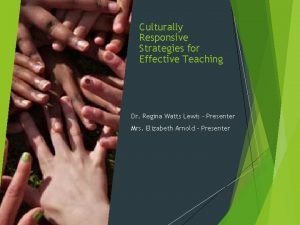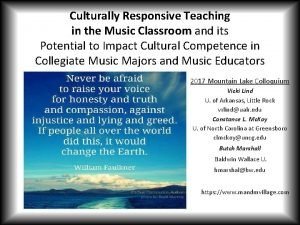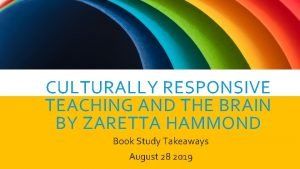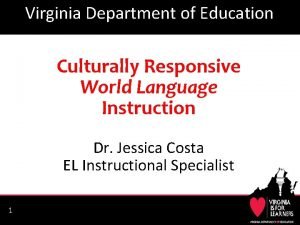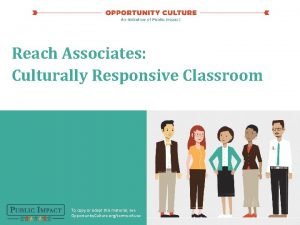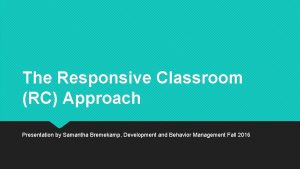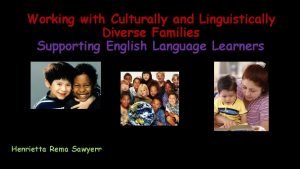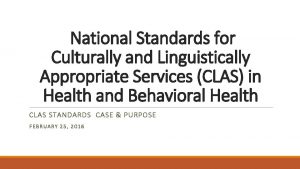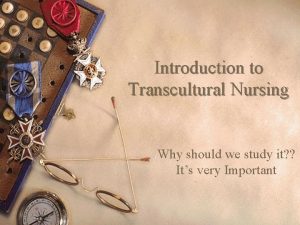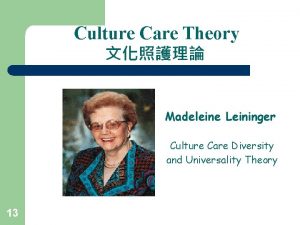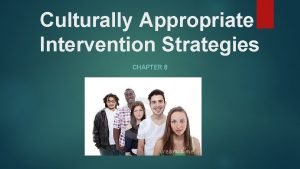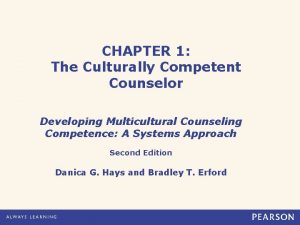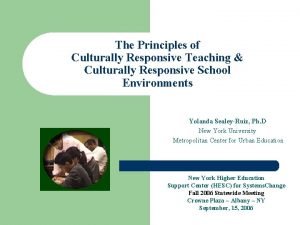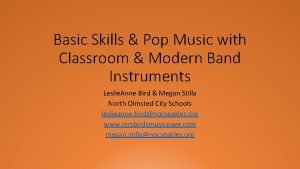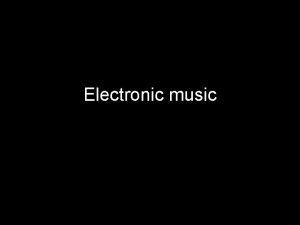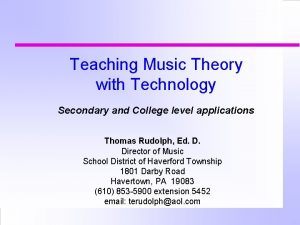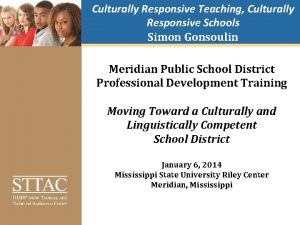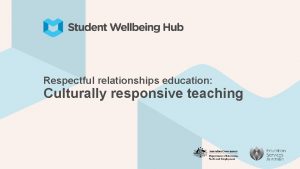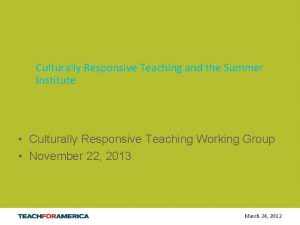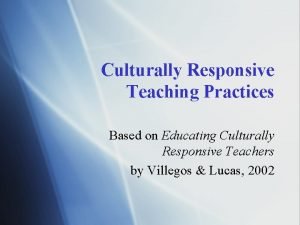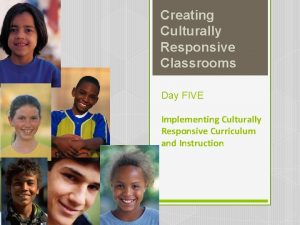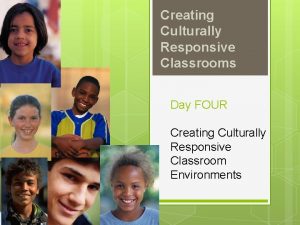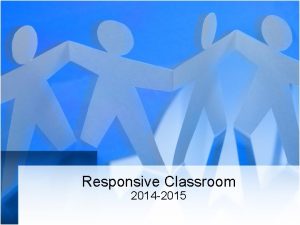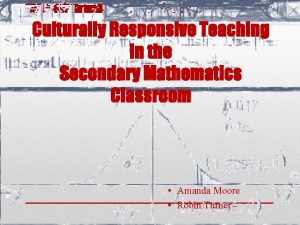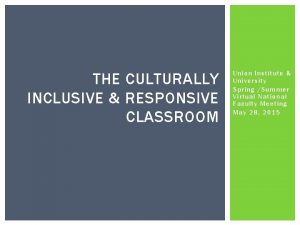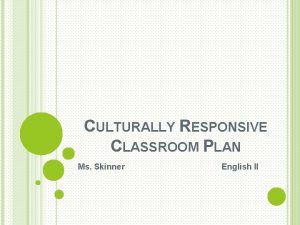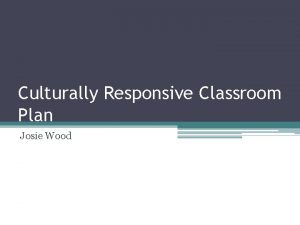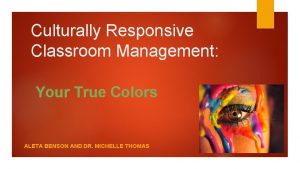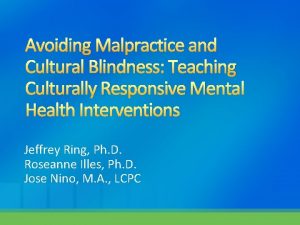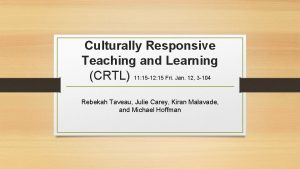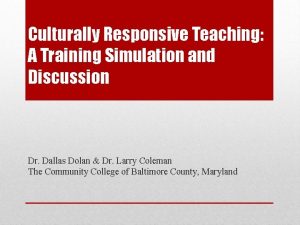Culturally Responsive Teaching in the Music Classroom and
























- Slides: 24

Culturally Responsive Teaching in the Music Classroom and its Potential to Impact Cultural Competence in Collegiate Music Majors and Music Educators 2017 Mountain Lake Colloquium Vicki Lind U. of Arkansas, Little Rock vrlind@ualr. edu Constance L. Mc. Koy U. of North Carolina at Greensboro clmckoy@uncg. edu Butch Marshall Baldwin Wallace U. hmarshal@bw. edu https: //www. mandmvillage. com

What is Culturally Responsive Teaching? Using the characteristics, experiences, and perspectives of culturally diverse students as conduits for teaching them more effectively. It teaches to and through students’ strengths. (Geneva Gay, 2010)

Key Principles in Culturally Responsive Teaching • • Know yourself Know your students Create a supportive classroom environment Make program and curricular decisions that are culturally responsive Lind, V. and Mc. Koy, C. (2016). Culturally responsive teaching in music education: From understanding to application. NY: Routledge.

Teacher Age Gender Cultural Values Cultural Identity Cultural Learning Styles Musical Experiences Musical Preferences Beliefs Expectations

Three-Part Model of Cultural Competence Attitudes/Beliefs Skills Knowledge

Diversity, by Gene Griessman http: //multiracialfamily. org/2011/08/16/poem-diversity/ Mirrors, Windows and Sliding Glass Doors

I believe, that diversity is a part of the natural order of things -as natural as the trillion shapes and shades of the flowers of spring or the leaves of autumn.

I believe, that diversity brings new solutions to an ever-changing environment, and that sameness is not only uninteresting but limiting.

To deny diversity is to deny life. With all its richness and manifold opportunities. Thus I affirm my citizenship in a world of diversity, and with it the responsibility to…

Be tolerant. Live and let live. Understand that those who cause no harm should not be feared, ridiculed, or harmed – even if they are different.

Look for the best in others. Be just in my dealings, with poor and rich, weak and strong, And whenever possible to defend the young, the old, the frail, the defenseless.

Be kind, remembering how fragile the human spirit is.

Live the examined life, subjecting my motives and actions to the scrutiny of mind and heart so to rise above prejudice and hatred.

Care.

Prompt #4 Draw upon Lind/Mc. Koy chs. 1 -5, particularly the strategies on p. 98, as well as on the video examples you watch this weekend. In our region of the country, the non-white race you are most likely to teach is Black or African-American. Thus, we have spent extra time on this group and their complex history. In a general music or ensemble setting, 1. how might you employ culturally responsive teaching to reach out to black students? 2. what community resources might you use to meet black families and learn more about their culture? 3. how would you learn about music that connects with black culture and do you have ideas for repertoire that might be both a mirror for your black students as well as a window for your other students? (do not feel constrained by instrumentation or budget - assume that this is a priority for your school and that there would be funds to make the music department more inclusive) • If you have a close friend who is black, this would be a great topic to share with your friend to better inform your answer.

A little context for prompt #4: Lind/Mc. Koy chapters 1 -5 1. Culture, education, and culturally responsive teaching. 2. Understanding how culture informs the development of teachers. 3. Understanding how culture informs learners’ experiences in the music classroom. 4. The intersection where teaching and learning meet. 5. Applications in the classroom.

A little context for prompt #4: Strategies for acknowledging ethnic and cultural diversity in music instruction: 1. Tune your car radio to a station you have never listened to and focus on the music. Listen critically for ways the music compares to things you are working on in class and use the music to reinforce these concepts with your ensembles. 2. Make a point of attending community events that feature music outside your area of expertise and listen for the unique characteristics of the performances. Take notes about the similarities and differences between the music performed and the pieces you are working on with your ensemble.

Cedar par 1: In my experience, there weren’t many kids that were minorities, especially black, in band. We had maybe two or three, depending on the year. I think that Black culture is a very interesting thing, and the history of African American culture specifically is so imperative to the development of music. I’m not sure why we didn’t learn much about this culture. But to be fair, we didn’t learn much about any culture. American marches are faster than English marches, sure. But why? Is there a reason? Where does the music in Jazz Band come from? I took a course on the history of the blues last semester for my FYE, and I learned about how tribal songs and work songs from West Africa came to the US, developed into blues, which branched into Rock and Roll, Jazz, Electric Blues, R&B, etc. This is all black culture, but we view it mostly as white culture. People look to The Beatles and the Rolling Stones as the bluesy, rock musicians who go down in history. But for some reason, Muddy Waters, Howlin’ Wolf, Chuck Berry, Son House, and Little Walter aren’t household names. The Rolling Stones do give much credit to Muddy Waters, having named their band after one of his most famous songs. Pink Floyd is named for blues musicians, but again, ones that are unrecognizable compared to the great rock bands that evolved from the music of the blues.

Par 2: So as far as including black culture in my classroom, I would simply teach these things. Music history is great, and Western music, especially American music, is relatively young compared to much other music. Before the I-IV -V-I pop song progression, we had this great wealth of culture in non -Western music. Much of general music is folk songs, and seeing as though this is a potential outcome for my degree, I think I need to think of ways to appropriately convey this message to children. Knowing the history of their own culture and other cultures is very important to the development of the individual’s concept of what music is. Any student of any color shouldn’t think that Eric Clapton invented the blues, and they should know the origins of all music and how, in the past 100 years, it evolved into what it is today mostly from the blues and from Western classical music.

Par 4: I remember being in elementary school, and we sang “We Shall Overcome. ” A room full of white kids. But the one black kid was singing loud and harmonizing with a call-and-response outside of the group unison. And I think the smartest thing a teacher could do is to let them. This is a student who, at a very young age, understands the culture and the meaning of the culture, and this is their way of expressing it. It may seem a little clownish, but it is right and proper in my mind, and as long is this kind of expression is monitored and regulated (in order to prevent it from becoming more of a joke than a learning experience) there should be no problem.

This is the list of languages (20) in which my Cleveland medical center provides instant translations. This card is at the sign -in station. What would happen if our education system was this accessible?

Hidden Figures – It matters that children see people in the media and pop culture who look like them.

Some examples that make an impact with my students (Butch) • Black/White Doll test • Yale study on implicit racial bias in preschool https: //www. youtube. com teachers (NPR report) /watch? v=yb. Da 0 g. Su. Acg https: //www. youtube. co • What is Privilege? https: //www. youtube. com m/watch? v=uc. EAc. IMk. S 0 c /watch? v=h. D 5 f 8 Gu. Nu. GQ

 Culturally responsive vs culturally relevant
Culturally responsive vs culturally relevant Culturally responsive teaching in music education
Culturally responsive teaching in music education Culturally responsive teaching and the brain slides
Culturally responsive teaching and the brain slides Culturally responsive classroom management
Culturally responsive classroom management Vdoe culturally responsive teaching
Vdoe culturally responsive teaching Culturally responsive teaching self assessment
Culturally responsive teaching self assessment Music music music
Music music music Responsive classroom youtube
Responsive classroom youtube Working with culturally and linguistically diverse families
Working with culturally and linguistically diverse families National culturally and linguistically appropriate services
National culturally and linguistically appropriate services Culturally deprived definition
Culturally deprived definition Campinha-bacote model
Campinha-bacote model Leininger sunrise model
Leininger sunrise model Culturally appropriate intervention strategies
Culturally appropriate intervention strategies Culturally competent counselor
Culturally competent counselor Pedagogy meaning
Pedagogy meaning Ways to address grammar in the writing classroom ppt
Ways to address grammar in the writing classroom ppt Btech smart classes
Btech smart classes Pop music for classroom
Pop music for classroom Micro teaching is a scaled down encounter
Micro teaching is a scaled down encounter Romantic vs classical music
Romantic vs classical music Loudness or quietness of music
Loudness or quietness of music A music that employs electronic musical instruments
A music that employs electronic musical instruments Pamulinawen instrument used
Pamulinawen instrument used Teaching music theory with technology
Teaching music theory with technology
